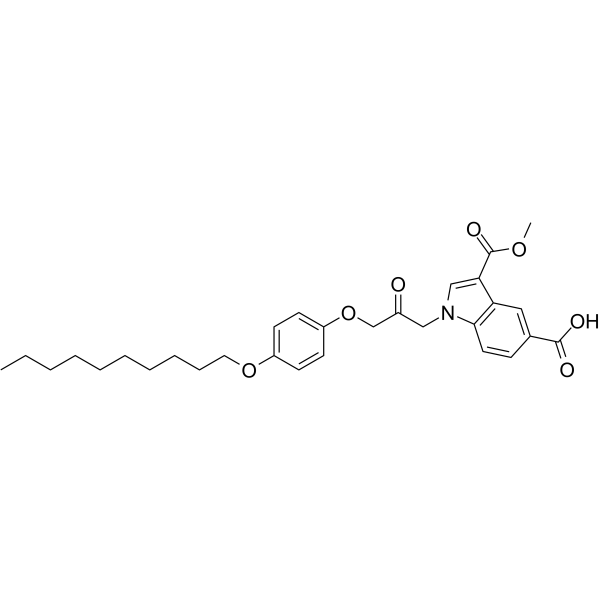888320-29-4
| Name | cay10502 |
|---|---|
| Synonyms |
1H-Indole-3,5-dicarboxylic acid, 1-[3-[4-(decyloxy)phenoxy]-2-oxopropyl]-, 3-methyl ester
1-{3-[4-(Decyloxy)phenoxy]-2-oxopropyl}-3-(methoxycarbonyl)-1H-indole-5-carboxylic acid |
| Description | CAY10502 is a potent, calcium-dependent cytosolic phospholipase A2 α (cPLA2α) inhibitor with an IC50 of 4.3 nM for isolated enzyme. CAY10502 can be used in the research of retinopathy and inflammatory diseases[1][2][3]. |
|---|---|
| Related Catalog | |
| Target |
cPLA2α:4.3 nM (IC50) |
| In Vitro | CAY10502 inhibits the release of arachidonic acid mediated by cPLA2R stimulanted with A23187 and TPA in human platelets, with IC50s of 0.57 and 0.0009 μM, respectively[1]. CAY10502 (5, 20, 50 nM; 12 hours; müller cells) inhibits normoxic- and hypoxia-induced Prostaglandin E2 (PGE2) and VEGF production[2]. CAY10502 (0.1-100 nM; 24 hours) inhibits the VEGF-induced proliferation of rat retinal microvascular endothelial cells (RRMEC)[2]. CAY10502 (10 μM) inhibits arachidonic acid (AA) release from the phospholipid pools, abrogated extremely low-frequency electromagnetic fields (ELF-EMF; 1 h) induced AA increase and the ELF-EMF inhibitory effect of Cav3.2 channels[3]. Cell Proliferation Assay[2] Cell Line: RRMEC Concentration: 0.1-100 nM Incubation Time: 24 hours Result: CAY10502 (35, 50 nM) demonstrated significant reductions in VEGF-induced proliferation (64.3% and 84.1%, respectively) compared with cultures treated with VEGF alone. |
| In Vivo | CAY10502-injected (2.5, 25, 100 nM; 5 μL) eyes demonstrates a dose-dependent inhibition of retinal neovascularization (NV) in rat oxygen-induced retinopathy (OIR)[2]. Animal Model: OIR and room air (RA) Sprague-Dawley rat[2] Dosage: 2.5, 25, 100 nM; 5 μL Administration: Intravitreal Injection Result: Injection of 100 nM CAY10502 resulted in a 53.1% reduction in NV compared with vehicle treatment. |
| References |
| Density | 1.2±0.1 g/cm3 |
|---|---|
| Boiling Point | 693.6±55.0 °C at 760 mmHg |
| Molecular Formula | C30H37NO7 |
| Molecular Weight | 523.617 |
| Flash Point | 373.3±31.5 °C |
| Exact Mass | 523.257019 |
| PSA | 104.06000 |
| LogP | 7.96 |
| Vapour Pressure | 0.0±2.3 mmHg at 25°C |
| Index of Refraction | 1.559 |
